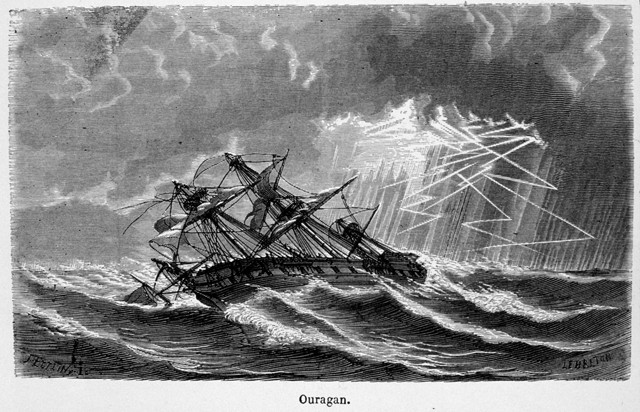
by Bethany Augliere Monday, May 15, 2017

The sailing ship Ouragan — depicted in "Les Meteores" by Margolle and Zurcher, 3rd edition, published in 1869 — labors at sea under hurricane conditions. Credit: NOAA Photo Library.
Despite improvements in oceanographic observation, knowledge gaps remain about the interactions between ocean waves and wind blowing over the water’s surface. This is in part due to the difficulty of observing the ocean in high seas and windy conditions. In a new study in Geophysical Research Letters, however, researchers have used a historical record of a treacherous 1883 at-sea rescue — aided by the wave-calming effects of a fish-oil slick — to develop a model of how wind and water interact to form different sizes and types of waves.
While searching through modern and historical records, the scientists examined an account of the Grecian, a merchant ship on its way from Philadelphia to Portugal in November 1883 when it got caught in a raging storm. Luckily for the crew, a rescue sailing ship, the Martha Cobb, came upon the Grecian at dawn on Nov. 15. The problem, however, was how to safely transport the crew from the Grecian to the Martha Cobb. According to the account, the master of the Martha Cobb, Thomas Greenbank, did not think the Cobb’s 5-meter dinghy could survive the rough seas.
To smooth the sea, Greenbank’s crew first pumped petroleum from the ship into the ocean. This did little to calm the breaking waves, however, because petroleum does not spread effectively enough on the surface of water to form a continuous film on the sea, says study co-author Xin Zhang, an oceanographer at the Scripps Institution of Oceanography in San Diego, Calif. Next, Greenbank dumped 19 liters of fish oil overboard. As opposed to hydrocarbon-rich petroleum, which does not mix well with water, fish oil is what’s known as a polar oil: While one end of the oil molecule is composed of hydrocarbons, the other end is polarized and attracted to water. This property both keeps the oil from quickly dispersing in water and allows it to spread continuously across water surfaces. Indeed, after about 20 minutes, the seas around the Martha Cobb and the sinking Grecian calmed enough so that the stranded crew could be transported to the Cobb.
“This record [of the Grecian] that Chip found really gave us the information that we needed,” Zhang says, referring to lead author Charles “Chip” Cox, also from Scripps, who passed away in November 2015 shortly after completing the paper’s first draft. Most accounts of oil dumping in the ocean that the research team looked at were descriptive and lacked the necessary quantitative information, Zhang says.
Several key details of the record helped the oceanographers construct their wind-wave model, including the fact that the crew used fish oil, the length of time it took the oil to take effect, and that breaking waves were visible in the distance beyond the oil slick. Cox and his co-authors used this information, along with assumptions about the oil-dumping rate, to estimate that the slick spread over about 0.36 hectares and that both vessels drifted 1 to 1.5 kilometers downwind behind the oil patch.
They hypothesized that the fish oil’s dampening effect on the large waves near the ships was less of a direct effect from the oil film itself, but rather an indirect effect due to how it affected the wind blowing over the water’s surface. The idea is that the oil suppressed small surface waves with wavelengths of just a few centimeters and which are constrained by surface tension. As the roughness of the water surface decreased, the wind-flow over the surface changed, which resulted in less energy feeding the larger waves with wavelengths up to 150 meters.
“I find that [explanation] very possible,” says John McHugh, a fluid dynamicist at the University of New Hampshire who was not involved in the study. However, while the paper provides a synoptic explanation of this event, the accuracy of the observations in the 1883 report is uncertain, he notes. “We don’t really know what happened; a lot of things can happen to two ships in a stormy ocean.”
“It is a thought-provoking and useful paper,” says Erick Rogers, an oceanographer with the U.S. Naval Research Laboratory at the Stennis Space Center in Mississippi, who was not involved in the new study. “Though the topic is not new, little attention has been paid to it within the waves community in recent years,” Rogers says.
Zhang points out that “the model is very primitive,” but says he hopes that researchers will continue to explore the topic by designing at-sea experiments. Better understanding of ocean-atmosphere coupling could help with large-scale weather forecasting models, which are currently unreliable, he says. Other questions yet to be addressed include how long the wave-calming effects of the oil last and how the structure of wind profiles change over smoothed seas. “There’s a lot of work ahead of us.”
© 2008-2021. All rights reserved. Any copying, redistribution or retransmission of any of the contents of this service without the expressed written permission of the American Geosciences Institute is expressly prohibited. Click here for all copyright requests.